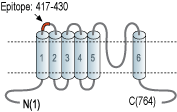Overview
- Peptide (C)KQAAPHLKAEVGNS, corresponding to amino acid residues 417-430 of human TRPV2 (Accession Q9Y5S1). 1st extracellular loop.

 Cell surface detection of TRPV2 by direct flow cytometry in live intact human THP-1 monocytic leukemia cells:___ Cells.
Cell surface detection of TRPV2 by direct flow cytometry in live intact human THP-1 monocytic leukemia cells:___ Cells.
___ Cells + Rabbit IgG Isotype Control-FITC (#RIC-001-F).
___ Cells + Anti-Human TRPV2 (VRL1) (extracellular)-FITC Antibody (#ACC-139-F), (5µg). Cell surface detection of TRPV2 by direct flow cytometry in live intact human MEG-01 megakaryoblastic leukemia cells:___ Cells.
Cell surface detection of TRPV2 by direct flow cytometry in live intact human MEG-01 megakaryoblastic leukemia cells:___ Cells.
___ Cells + Rabbit IgG Isotype Control-FITC (#RIC-001-F).
___ Cells + Anti-Human TRPV2 (VRL1) (extracellular)-FITC Antibody (#ACC-139-F), (5µg).
- Montell, C. et al. (2002) Mol. Cell 9, 229.
- Clapham, D.E. (2003) Nature 426, 517.
- Moran, M.M. et al. (2004) Curr. Opin. Neurobiol. 14, 362.
- Clapham, D.E. et al. (2003) Pharmacol. Rev. 55, 591.
- Gunthorpe, M.J. et al. (2002) Trends Pharmacol. Sci. 23, 183.
- Tominaga, M. and Caterina, M.J. et al. (2004) J. Neurobiol. 61, 3.
- Voets, T. et al. (2004) Nature 430, 748.
- Pedersen, S.F. et al. (2005) Cell Calcium 38, 233.
- Muraki, K. et al. (2003) Circ. Res. 93, 829.
- Shimosato, G. et al. (2005) Pain 119, 225.
- Saunders, C.I. et al. (2007) Mol. Immunol. 44, 1429.
- Caterina, M.J. et al. (1999) Nature 398, 436.
TRP channels are a large family (about 28 genes) of plasma membrane, non-selective cationic channels that are either specifically or ubiquitously expressed in excitable and non-excitable cells.1 The TRP channels have six putative transmembrane domains (TM) with a pore domain between the fifth and the sixth TM, and all assemble as tetramers. Both the N- and the C-termini of all TRPs are intracellular3.
According to IUPHAR, the TRP family is comprised of numerous subfamilies on the basis of sequence homology; TRPC, TRPM, TRPV, TRPA, TRPML, and TRPP1-4. The TRPV subfamily consists of six members, TRPV1-65.
Four members of the TRPV family have been described as thermosensitive ion channels (TRPV1 to TRPV4). Each channel exhibits distinct thermal activation thresholds ranging from noxious cold (<17°C) to noxious heat (>52°C) 6,7. Although it shares around 50% homology with TRPV1, TRPV2 is not activated by capsaicin nor by protons. It has a high temperature threshold of ~52°C and is considered to play an essential role in the perception of high-intensity noxious heat stimulation8-10. TRPV2 is also considered to be a stretch-activated channel and to play a role in skeletal and cardiac muscle degeneration and pain pathway8. The TRPV2 channel is expressed in DRG neurons, different brain regions and non-neuronal tissues such as the spleen, lung and intestine and in components of the immune system5,11,12.
Application key:
Species reactivity key:
Anti-Human TRPV2 (VRL1) (extracellular) Antibody (#ACC-139) is a highly specific antibody directed against an extracellular epitope of the human protein. The antibody can be used in western blot and live cell flow cytometry applications. It has been designed to recognize TRPV2 from human samples only.
Anti-Human TRPV2 (VRL1) (extracellular)-FITC Antibody (#ACC-139-F) is directly conjugated to fluorescein isothiocyanate (FITC) fluorophore. This conjugated antibody has been developed to be used in immunofluorescent applications such as direct flow cytometry and live cell imaging. It has been designed to recognize TRPV2 from human samples only.
